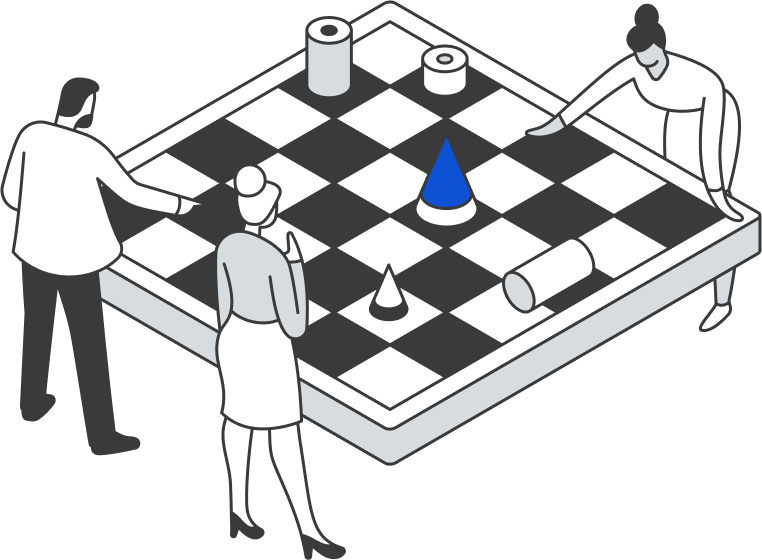10 Reasons for Portfolio Management of Data & AI Use Cases
In this article, we will show you why a use case portfolio management is essential to drive innovation and operational excellence in data & AI. We summarize the 10 most important reasons for this. You will also find out what special role use cases play in the AI strategy and what helps you get the most out of your AI initiatives.
Read time: 3-4 min.

Look around
The game has changed.
The use of Data Analytics and AI applications is undeniably the key driver for business success. The user-friendly cloud architectures of the big providers and foundation models such as GPT have given this a massive boost. From a technological perspective, the development of innovative data and AI products has never been as accessible and easy as it is today. With the increasing importance of data and AI, the number of use cases that need to be maintained, managed, and monitored is also growing.
However, this progress goes hand in hand with increasing expectations of these products. Customers expect tailored solutions for their individual problems and a high level of data protection. In the workplace, employees demand the smooth operation of this technology and more transparency, as well as the opportunity to contribute. And managers are focusing on the promised return on their investment.
At the same time, the initial euphoria from the experimentation and testing phases slows down and confronts many companies with new challenges:
The costs of implementing and scaling AI products often seem too high, the risk profile of AI and data must be addressed with specific measures, and the growing complexity of development projects requires clearly defined processes. In addition, transparency about initiatives and their progress is lost during these rapid changes.

Against this backdrop, effective and efficient management of all individual Data and AI use cases is of high importance. This is where portfolio management comes in place. Such a portfolio enables companies to maintain an overview and systematically manage all aspects from idea generation to implementation and scaling. With such a management approach, they can handle complexity and create the foundation for a long-term successful data and AI strategy.
Companies that neglect this strategic component, risk not only financial losses but also the loss of customers and skilled employees to competitors who invest in proactive management of their Data & AI projects. An efficient portfolio is therefore not a luxury, but a necessity to remain competitive in today’s fast-paced business world.

Data Analytics & AI Use Cases
At the heart of change.
A comprehensive AI strategy consists of three central pillars: a clearly defined vision, a well-structured portfolio of AI use cases, and an optimal combination of input factors or key resources.
Use cases are, so to speak, the translator of the vision, strategic goals, and operational challenges into specific projects and represent the areas where the company can most benefit from data and AI; whether for a specific product, a service, or a process improvement.
At the same time, use cases are the connecting element to the needed input factors such as personnel, organizational structures, and technology, to ensure that they can fully unfold their potential in the implementation.
Continue with purpose
A well-organized and user-oriented portfolio
It’s time to understand and take control of your Data Analytics & AI use cases. A use case portfolio is a central tool in the transformation of your company through the systematic creation and management of data analytics and AI applications via a connecting platform The goal is to maintain an overview throughout the entire lifecycle and ensure that resources are allocated to those projects that are aligned with the company’s strategic goals and contribute the maximum value.
- Consider, for example, a situation where you are faced with a mountain of use case ideas and now have the difficult task of filtering out those that currently are the most promising ones.
- Maybe you want to draw on valuable insights from past projects and reuse already developed code, models, or data sets.
- Or you need to ensure that a complex use case, which is carried out for different interest groups, meets all relevant compliance steps and quality requirements.
At this point, a well-organized and user-oriented portfolio of Data & AI Use Cases offers a solution. It ensures a transparent and systematic structure that makes it easier to handle these challenges.
If you are not yet convinced, consider the following 10 reasons that further highlight the benefits of such a portfolio:
TOP 10 Reasons For A Data & AI Use Case Portfolio
1) Overview and Organization: It provides a structured view of all Data Analytics and AI use cases within an organization. This helps to easily monitor the progress and status of each project.
2) Resource Allocation: With a clear overview of all ongoing and planned projects, companies can efficiently allocate resources (such as budget, personnel, and technology).
3) Prioritization: Based on the portfolio, decision-makers can identify which projects have the highest business value and are the most difficult to implement, and prioritize them accordingly.
4) Risk Management: A portfolio approach enables the identification and management of risks across various projects, instead of considering them in isolation.
5) Strategic Alignment: A Data Analytics and AI Portfolio ensures that all initiatives and projects are aligned with the overarching business goals and strategies.
6) Enhancement of Collaboration: A portfolio can help teams and departments recognize synergies, leading to better collaboration and sharing of best practices.
7) Continuous Improvement: With a portfolio, companies can analyze successes and failures across projects and learn from them to improve future projects.
8) Stakeholder Communication: It provides a platform for transparent communication with stakeholders so they are informed about the status, progress, and value of Data Analytics and AI initiatives.
9) Reuse of Resources: A centralized portfolio makes it easier to find and reuse code, models, tools, and other resources developed in previous projects.
10) Compliance and Governance: Especially with AI, a portfolio can help ensure that all projects comply with ethical guidelines and legal regulations.
Conclusion
Professional portfolio management for data analytics and AI forms the backbone of a forward-looking company by driving innovation and operational efficiency while simultaneously minimizing risks. This strategic approach ensures that investments in technology projects are strictly aligned with corporate goals and that only those initiatives that demonstrably deliver added value receive support. This ensures sustainable and targeted use of corporate resources while maintaining compliance and quality standards across all stakeholders.

Traditional tools like PowerPoint, Confluence, and Excel or even specialized task management tools like Jira often reach their limits here. They are useful for individual tasks, but they lack the ability to depict the complex relationships and the strategic importance of the individual projects within the overall portfolio. They do not provide the necessary depth and flexibility to manage dynamic prioritizations, dependencies, and risk assessments in real time.
Therefore, systematic portfolio management forms the foundation for a resilient and future-proof company capable of using its data and AI resources consciously and effectively. It fosters a culture where data and AI are understood as an integral part of the company’s strategy.
How Casebase Supports YOU
Casebase provides you a structured framework to translate your AI vision and strategy into a clean portfolio of practical use cases. Align people, technology, and governance to create impactful data and AI-driven innovation.
Here are some features that enables you to make the most of your new data analytics and AI portfolio.

Summary Tab
Quickly get into specific use cases and understand the problem, purpose, and added value.

Prioritization Matrix
See and understand what your most value-driven use cases are to make valid prioritization decisions.

Quality Gate Checklist
Ensure requirements and compliance standards are met to drive high-quality use cases.
–> See further Casebase features.

Free Trial, fast Onboarding

Training & support included

